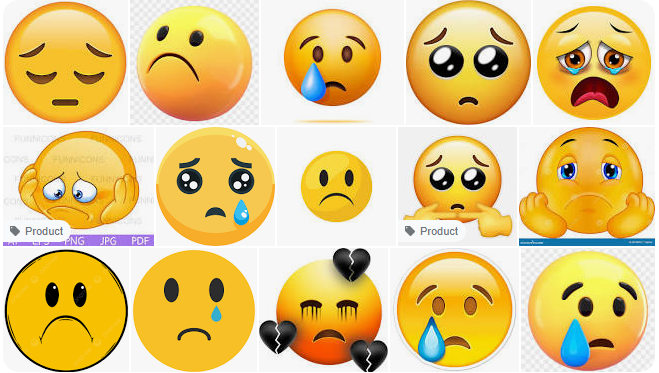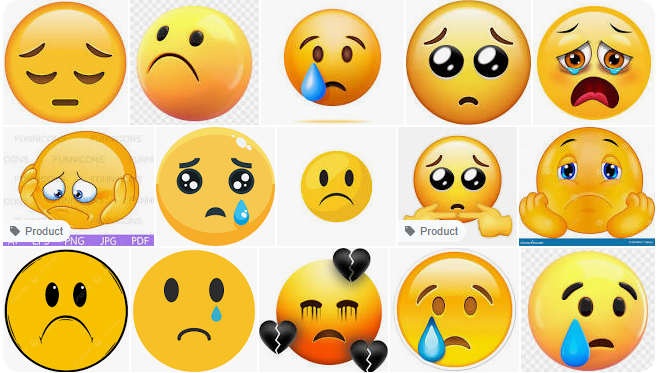Sad emojis are a popular way to convey sadness or disappointment in digital communication. They are often used to express feelings of sadness, grief, or disappointment in a way that words alone cannot. Understanding when and where to use a sad emoji can help to communicate emotions more effectively.
Emojis have become an essential part of digital communication, and they are used to convey emotions, tone, and meaning in written text. The sad emoji is one of the most widely used emojis and can be used to express a wide range of emotions, including sadness, disappointment, and grief. However, it is essential to understand the role of the sad emoji and where to use it to avoid misinterpretation.
Knowing when and where to use a sad emoji can help to convey emotions more effectively and avoid misunderstandings. Using a sad emoji in the right context can help to express empathy, show support, or convey a sense of sadness or disappointment. However, using a sad emoji in the wrong context or overusing it can lead to misinterpretation and confusion.

Key Takeaways
- Sad emojis are a popular way to convey sadness or disappointment in digital communication.
- Understanding when and where to use a sad emoji can help to communicate emotions more effectively.
- Using a sad emoji in the right context can help to express empathy, show support, or convey a sense of sadness or disappointment.
Understanding Emojis
Emojis are an essential part of digital communication. These small icons and images are used to convey emotions, feelings, and messages in a fun and creative way. They can be used to express happiness, sadness, anger, love, and many other emotions.
The use of emojis has become increasingly popular in recent years, with people using them in text messages, social media posts, and emails. Emojis can help to add context and emotion to a message, making it easier to understand the tone of the conversation.
One of the most commonly used emoji is the sad face emoji. This emoji is used to express sadness, disappointment, or grief. It is often used in situations where someone is feeling down or upset about something.
There are several variations of the sad face emoji, including the crying face emoji, the pensive face emoji, and the disappointed face emoji. Each of these emojis has its own unique meaning and can be used in different situations.
It is essential to use emojis appropriately and in the right context. Using the wrong emoji can lead to confusion or misinterpretation of the message. It is also important to remember that not everyone understands the meaning of every emoji, so it is essential to use them sparingly and with caution.
In conclusion, emojis are a fun and creative way to express emotions and feelings in digital communication. Understanding the meaning of each emoji and using them appropriately can help to improve communication and make conversations more enjoyable.
The Role of the Sad Emoji
Sadness is a universal emotion that everyone experiences at one point in their lives. The sad emoji is a powerful tool that can be used to express this emotion in digital communication. It is a simple and effective way to convey empathy, sympathy, and support to someone who is going through a difficult time.
The sad emoji can be used in a variety of contexts, including personal and professional communication. In personal communication, it can be used to express condolences, offer emotional support, or simply show that someone is feeling down. In professional communication, it can be used to express empathy towards a colleague who is going through a tough time, or to acknowledge a difficult situation.
It is important to use the sad emoji appropriately and in the right context. Overuse of the sad emoji can come across as insincere or disingenuous. It is important to consider the tone of the conversation and the relationship between the parties involved before using the sad emoji.
In conclusion, the sad emoji plays an important role in digital communication. It is a powerful tool that can be used to express empathy, sympathy, and support towards someone who is going through a difficult time. However, it is important to use it appropriately and in the right context to avoid coming across as insincere or disingenuous.
Where to Use a Sad Emoji
Sad emojis can be used in various contexts to express sadness, empathy, or sympathy. Here are some examples of where a sad emoji can be used:
Personal Messaging
When communicating with friends or family members through personal messaging apps, using a sad emoji can convey a sense of empathy or sympathy. For instance, if a friend shares some bad news, sending a sad emoji can show that you understand and care about their feelings. Similarly, if you are feeling down and want to express your emotions, using a sad emoji can help you convey your mood to others.
Social Media Posts
In social media posts, sad emojis can be used to express a range of emotions, from mild disappointment to profound sadness. For example, if you are sharing a post about a recent loss or a tragic event, using a sad emoji can show that you are mourning or grieving. Similarly, if you are sharing a post about a personal setback or disappointment, using a sad emoji can convey your feelings of sadness or frustration.
Email Communication
In professional or formal email communication, using a sad emoji may not be appropriate. However, in more casual or personal emails, a sad emoji can help you convey your emotions in a more nuanced way. For example, if you are emailing a colleague or client about a project that did not go as planned, using a sad emoji can show that you are disappointed or frustrated with the outcome.
Overall, using a sad emoji can help you express your emotions in a more nuanced and empathetic way. However, it is important to use them appropriately and in context to avoid misunderstandings or misinterpretations.
The Impact of Using a Sad Emoji
Using a sad emoji can have a significant impact on the way a message is perceived. It can help the sender to express empathy and convey their personal feelings more effectively. In this section, we will explore the impact of using a sad emoji in more detail.
Expressing Empathy
One of the main benefits of using a sad emoji is that it can help the sender to express empathy towards the recipient. When someone is going through a difficult time, receiving a message with a sad emoji can help them to feel understood and supported. It can also help to create a more personal connection between the sender and the recipient.
Conveying Personal Feelings
Another benefit of using a sad emoji is that it can help the sender to convey their personal feelings more effectively. When someone is feeling sad, it can be difficult to put those feelings into words. Using a sad emoji can help to convey the message more clearly and can make the recipient more likely to understand and empathize with the sender’s feelings.
In conclusion, using a sad emoji can have a significant impact on the way a message is perceived. It can help the sender to express empathy and convey their personal feelings more effectively.
Avoiding Misinterpretation of Sad Emoji
When it comes to using sad emojis, it’s important to be cautious and considerate. While a sad emoji can convey a range of emotions, it can also be easily misinterpreted. Here are some guidelines to keep in mind when using sad emojis:
- Use sad emojis sparingly: Overuse of sad emojis can make the recipient feel overwhelmed or uncomfortable. It’s best to only use a sad emoji when it’s necessary to convey a particular emotion.
- Consider the context: The context of the conversation is important when using a sad emoji. If the conversation is light-hearted, using a sad emoji can come across as insincere or sarcastic.
- Avoid using sad emojis in a professional setting: In a professional setting, using a sad emoji can be seen as unprofessional or inappropriate. It’s best to stick to more neutral emojis in these situations.
- Be aware of cultural differences: Different cultures may interpret emojis differently. It’s important to be aware of these differences and avoid using emojis that may be offensive or inappropriate in certain cultures.
By following these guidelines, you can avoid misinterpretation and effectively convey your emotions through the use of sad emojis.
Conclusion
In conclusion, the sad face emoji is a powerful tool for expressing emotions in digital communication. Its versatility makes it suitable for a wide range of situations, from expressing empathy and concern to conveying disappointment or sadness. Proper use of the sad face emoji can enhance the emotional impact of a message and help the recipient understand the sender’s feelings more clearly.
It is important to use the sad face emoji appropriately and in context. Overuse of the sad face emoji can diminish its impact and make the sender appear insincere or overly emotional. On the other hand, failing to use the sad face emoji when appropriate can make the sender appear indifferent or uncaring.
Overall, the sad face emoji is an important part of modern communication. By using it effectively, individuals can enhance their ability to express emotions and connect with others in meaningful ways.
Frequently Asked Questions
What is the meaning of the 😔 emoji?
The 😔 emoji is typically used to express a sense of disappointment or sadness. It can be used to convey a range of emotions, such as feeling down, discouraged, or disheartened.
When is it appropriate to use the 😭 emoji?
The 😭 emoji is typically used to express intense sadness or grief. It can be used to convey a range of emotions, such as crying, mourning, or feeling overwhelmed with emotion. It is appropriate to use the 😭 emoji in situations where the person is experiencing a significant loss or is feeling deeply emotional.
What is the difference between 😔 and 😢?
The 😔 emoji is used to express general sadness or disappointment, while the 😢 emoji is used to express a more intense or specific type of sadness. The 😢 emoji is typically used to express a sense of loss or heartbreak.
What are some common situations where people use the 😞 emoji?
The 😞 emoji is commonly used to express a sense of disappointment or dissatisfaction. It can be used in situations where someone is feeling let down, frustrated, or upset about something that did not go as planned.
How can the 😔 emoji be used in a meme?
The 😔 emoji can be used in memes to express a sense of disappointment or sadness in a humorous way. For example, a meme might show a person looking sad and disappointed with the caption “When you realize it’s Monday tomorrow.”
What is the significance of the 😥 emoji compared to other sad emojis?
The 😥 emoji is typically used to express a sense of sadness or disappointment, but it can also be used to convey a sense of sympathy or empathy for someone else who is going through a difficult time. It is often used in situations where someone is expressing their condolences or offering support to someone who is grieving.
Also read:
